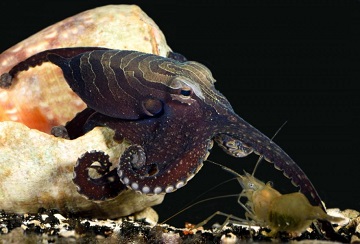SATS-169-octopus-website.jpg

The larger Pacific striped octopus is unique in more ways than one. Credit: Roy Caldwell/UC Berkeley
Most octopus species hunt by probing holes or lunging at prey with all eight arms. But the larger Pacific striped octopus is not like most octopuses. This large species is more subtle—and sly. When it spots prey, the octopus shrinks itself and sneaks up to its mark. Then the cephalopod simply reaches out and… well actually, it gently taps its prey. The prey is so startled that it jumps into the octopus’s waiting arms, or the octopus uses the moment to grab dinner.
And that’s not the only way this species differs from its brethren. The Pacific striped octopus is also quite social. Most octopuses are loners, but scientists have found several dozen Pacific striped octopuses hanging together in the Pacific near Nicaragua and Panama.
These striped beauties aren’t afraid of romantic entanglements either. Unlike the brief, arm’s-length transfer of sperm most octopus species use during mating, a male and female Pacific striped octopus spend time together, sometimes sharing meals beak-to-beak and staying attached to each other for several days.
After the female lays a clutch of eggs, she mates again, and again, and again over several months. Most octopus mothers lay a single clutch of eggs, brood them until they hatch and die shortly after, but Pacific striped mothers go on hunting, mating and laying more eggs even after multiple hatchings.
When a Panamanian biologist first observed these behaviors in the 1970s, other scientists rejected them as too bizarre to be true, until recently, when others saw these behaviors for themselves. But it’s possible the Pacific striped octopus isn’t all that unusual. So few octopus species have been closely studied that biologists may yet discover even stranger lifestyles among others.


